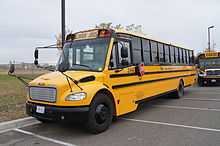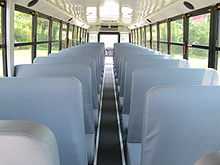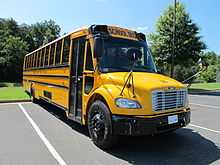Thomas Saf-T-Liner C2
| Thomas Saf-T-Liner C2 | |
|---|---|
 Front 3/4 view | |
 Interior view, looking back | |
| Overview | |
| Manufacturer | Thomas Built Buses |
| Production | 2004-present |
| Assembly | High Point, North Carolina |
| Body and chassis | |
| Chassis | Freightliner C2 |
| Related | Freightliner M2 Business Class |
| Powertrain | |
| Engine |
|
| Capacity | 14-81 |
| Dimensions | |
| Width | 96 in (2,438 mm) |
| Curb weight | 18,000–35,000 lb (8,165–15,876 kg) (GVWR) |
| Chronology | |
| Predecessor |
|
The Thomas Saf-T-Liner C2 (often shortened to C2) is a Type C (conventional-style) school bus produced by Thomas Built Buses. In production since 2004, the C2 is based on a Freightliner C2 chassis, itself derived from the Freightliner M2 Business Class medium-duty conventional. It was introduced as the replacement for the Thomas Conventional and Thomas Saf-T-Liner FS-65; the latter was produced alongside the C2 until December 2006.[1] Due to elements of its design, the C2 can also be considered the successor to the Vista line of Type C buses from the 1990s.
The Saf-T-Liner C2 is built at a $40 million manufacturing facility in High Point, North Carolina.[2]
Overview


Following the introduction of the Freightliner Business Class M2 medium-duty truck in 2002 as the replacement for the FL-Series, Freightliner began work on an all-new bus chassis based on the M2 to replace the FS-65 bus chassis. As the parent company of Thomas Built Buses, Freightliner sought to pair the new bus chassis together with a new Thomas body, allowing the bus company to update its Saf-T-Liner Conventional bus body for the first time since 1962.
Dubbed the Freightliner C2 (although badged as Thomas), the M2-derived chassis differed from previous cowled-chasis conventionals in its use of stock components. Previously, from the hood back, little more than the manufacturer's steering column and gauge cluster was used. In the C2, the entire dashboard of the Freightliner M2 106 was carried over intact into the bus; while the bus would end up with a taller windshield, even the windshield wipers were shared parts. For the first time in a conventional bus, a curved, bonded windshield was used. In addition to improve the overall aerodynamics of the vehicle, the design was chosen in order to resist chips by more effectively deflecting objects.[3]
Along with an all-new chassis, Thomas chose an all-new body for its new bus, named the Saf-T-Liner C2. Aerodynamics would play a large role in its outward design, with its large windshield sloped back and the hoodline lowered (in comparision to its predecessor). Where state regulations allow, the lenses for the red and yellow warning lights are faired into the body as well. As a key factor of school bus safety, improved sightlines would play a large role in the C2 as well, with minimized blind spots; similar to the Thomas Vista and nearly all small school buses, the C2 has a large window ahead of the main entry door to improve visibility around the loading zone. The passenger windows themselves were made larger, which also allowed for larger emergency exits.[4]
As the first new Thomas full-size bus body in 40 years, manufacturing techniques for the C2 were redesigned as well. To minimize the number of rivets and welds on the bus body, adhesive bonding was used for many body joints. In the cases where fasteners are needed, self-piercing rivets are used; ideally these do not punch completely through the bottom layer of the metals being joined together, thus reducing the likelihood that rivets will become the source of leaks in the future. To simplify vehicle maintenance, Thomas introduced multiplexed wiring, replacing individually wired circuits. In the system used in the C2, it also has the advantage that switches on the control panel next to the driver can be rearranged to suit the driver and continue to function without any rewiring or reprogramming. An electrically powered entrance door was an option in late 2012.
The Saf-T-Liner C2 was introduced in 2004, two years after the M2 was introduced. For the first two years of its production, it was sold alongside the Saf-T-Liner/Freightliner FS-65. Two engines were available: the Caterpillar C7 and the Mercedes-Benz MBE900; both were shared with the FS-65 and the C7 with the Saf-T-Liner EF. The C2 is unique in that it is available in capacities up to 81 passengers, the largest of any type C conventional school bus in current production.[5]
In late 2007, a minor update to the Saf-T-Liner C2 was made. To improve driver sightlines, the mirror bracket for the passenger-side rear-view mirrors was extended. The passenger windows were redesigned, with equal-sized window sashes (previously, the top was larger). In the rear, the taillights are redesigned and enlarged. The Cummins ISB is introduced, becoming the sole engine by the end of 2008, replacing both the Caterpillar C7 and the Mercedes-Benz MBE900.
In October 2012, Thomas delivered its 50,000th Saf-T-Liner C2 to Dean Transportation of Lansing, Michigan.
Powertrain
Currently, the C2 is available with a single engine, the Cummins ISB; previously, the MBE 900 from Mercedes-Benz was an option.[6] There have been reports of excessive lube oil usage in 2007 emissions-compliant Mercedes-Benz engines. Apparently, the problem corrects itself after 20,000 miles of service. If the customer does not want to wait or does not see an improvement in oil consumption, they can opt to have the engine repaired with an extended warranty.
The C2 comes standard with an Allison 2500 automatic transmission, with an Allison 3000 automatic transmission as an option. The C2 is also available with a Fuller 6 speed manual transmission as an option, and is the only school bus currently sold in North America that offers a manual. However, this is a very rare option.
C2e Hybrid
In 2007, Thomas introduced a hybrid-electric version of the Saf-T-Liner, named the C2e. Designed as a parallel hybrid, the C2e retains the Cummins ISB engine, adding a lithium-ion battery pack with an electric motor/generator. In the summer of 2013 Thomas removed the C2e product literature from their website; it is uncertain if the C2e remains an offered product.
Propane c2
In late 2012, Thomas introduced a propane-fueled variant of the Saf-T-Liner C2, utilizing an 8.0L V8 LPG engine from General Motors. This engine is completely different than the previous 8.1 liter GM truck engine. The two engines share no parts, as the new 8L engine was designed with water jackets between the cylinders, unlike the old 8.1. Propane has 18 times the hydrogen content of CNG, so the engine must run cool when operating on propane. The 8L engine was purpose-designed to operate in the high-temperature environment that burning propane creates. The new 8.0 liter engine is square, with both a 4.25 inch bore and stroke. GM has no plans to offer the new 8.0 liter industrial engine in its own trucks at this time. Original dyno development tests on the first GM 8.0 engine operating on gasoline, showed 518 Lb feet of max torque at 1,800 RPM with a slightly higher compression ratio than the old 8.1 which had a 9.1:1 CR. GM showed a 2 percent power increase on the old 8.1 liter on propane compared to gasoline on its Industrial version of the 8.1 engine at 511 Lb feet at 1,800 RPM. On CNG, natural gas, exactly the same engine on the same dyno reached only 460 Lb feet of torque at the same 1,800 RPM. Propane burns very hot and has 104.5 octane ( R+M ) so knocking and pinging are not a problem with higher than normal compression ratios. The higher the CR, the better the fuel mileage and power at all RPM levels. Propane is very widely distributed in North America and the standard automotive grade is HD5. The HD5 grade of propane is the most pure and consistent in the world as used for automotive fuel. It is limited to only 4 to 6 percent butane, unlike the LPG sold in Europe which has butane levels of about 30 percent.
Comparable products
External links
- Yellow Bus, Thomas Saf-T-Liner C2 - Thomas Built Buses - manufacturer website
| Wikimedia Commons has media related to Thomas Saf-T-Liner C2. |
See Also
References
- ↑ http://www.thomasbus.com/bus-models/type-c/fs65-retired.asp
- ↑ http://www.thomasbus.com/bus-models/school/saf-t-liner-c2/overview.asp
- ↑ http://www.thomasbus.com/bus-models/school/saf-t-liner-c2/standard-features.asp
- ↑ http://www.thomasbus.com/bus-models/school/saf-t-liner-c2/safety.asp
- ↑ http://www.thomasbus.com/bus-models/school/saf-t-liner-c2/standard-features.asp
- ↑ http://www.freightlinerchassis.com/sbMain.asp?page=C2
| ||||||||||||||||||||||||||||||||||
| ||||||||||||||||||||||||||||||||||||||||||